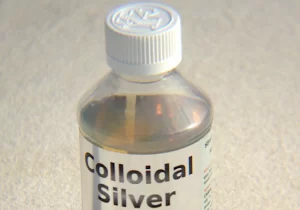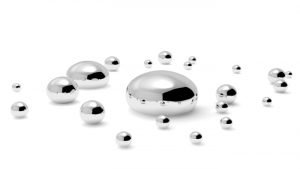Colloidal silver is a popular natural remedy used for centuries to treat various infections. Today, it is still used by many people as an alternative treatment for bacterial infections. While there is limited scientific evidence to support its efficacy, some believe that colloidal silver can effectively treat bacteria. In this article, we’ll take a closer look at how colloidal silver works and whether or not it can be effective against bacteria.
How Colloidal Silver Works
Colloidal silver works by binding to the proteins in the cell walls of bacteria, disrupting their metabolism and causing them to die. Additionally, colloidal silver can help to reduce inflammation and swelling.
The Effectiveness of Colloidal Silver as Documented by Science
Let us begin by highlighting an amazing analysis of clinical research titled “Silver Nanoparticles: The Powerful Nanoweapon Against MultidrugResistant Bacteria,” published in the Journal of Applied Microbiology in 2012.
The review, published in PubMed and has received 288 citations, looked at research on silver nanoparticles as of 2012. Simply put, it’s one of the greatest and most thorough clinical studies of antimicrobial silver we have ever read (and we should emphasize that we’ve been studying silver’s use against infectious germs for about 20 years).

You’ll notice that there is no question about colloidal silver’s demonstrated efficacy against bacteria resistant to many drugs in the review. The study authors’ summary is provided below:
“In the current environment, the multidrug-resistant (MDR) human pathogenic microorganisms present problems to the pharmaceutical and biomedical sectors.
Drug and antibiotic resistance, which is [a] acquired way of microorganisms to survive and reproduce in unpleasant conditions, facilitates the re-emergence of multidrug-resistant (MDR) microbes.
MDR bacterial infections significantly raise mortality, morbidity, and treatment costs when they persist. Therefore, a priority topic for study is the discovery, modification, or search for antimicrobial agents that can kill MDR bacteria.
Since the beginning, Ayurveda has employed silver to cure various bacterial illnesses. Silver is used in Bahamas or Ayurvedic medicinal formulations.
[products ]
Silver nanoparticles are the new hope for treating dangerous bacteria because many of them are becoming resistant to antibiotics. The bactericidal efficacy of silver nanoparticles against MDR bacteria is discussed in this paper. Drug-resistant bacteria can be treated and prevented with this multifunctional nano-weapon.
The review’s introduction follows the summary. The authors remark that due to silver’s potent antibacterial properties, it has been utilized since prehistoric times. However, the use of silver fell off after the development of synthetic antibiotics employed in modern medicine.
According to the authors, silver nanoparticles with a size between 10 and 100 nanometers (nm) exhibit the strongest antibacterial potential against both Gram-positive bacteria like Streptococcus and Staphylococcus and Gram-negative bacteria like E. coli. The research suggests that silver’s antimicrobial effects can be enhanced by adjusting the size of silver nanoparticles. Unlike Gram-negative bacteria, which do have an outer cell membrane, Gram-positive bacteria do not.
The bactericidal activity of silver nanoparticles against multidrug-resistant as well as multidrug-susceptible strains of bacteria had been studied by numerous scientists, the authors continued in their introduction, and science had demonstrated that silver nanoparticles were, in fact, “powerful weapons” against various types of multidrug-resistant bacteria.
The clinical reviewers noticed the following under the category “Silver-based antimicrobials: prehistorical, historical, and present status”:
Since silver ions are highly reactive and attach to proteins, the bacterial cell wall and nuclear membrane undergo structural alterations that result in cell deformation and death.
Silver ions can prevent bacterial replication by adhering to and denaturing bacterial DNA, according to three clinical investigations cited by the authors. Silver ions also interact with a class of thiol proteins, which causes DNA condensation and the death of bacterial cells.
The review explains the following in the section labeled “Nanoparticles”:
Due to their high surface-area-to-volume ratio, metallic nanoparticles, including copper, titanium, magnesium, zinc, gold, and alginate, have a potent bactericidal effect (Gu et al. 2003; Ahmad et al. 2005).
Silver nanoparticles are the most effective antibacterial agents against bacteria, viruses, and other eukaryotic microorganisms.
Remember that the conclusions of the numerous clinical research that the reviewers looked at served as the foundation for these assertions. To put it another way, they extracted this knowledge from published clinical research.
[ products ]
The review states that silver nanoparticles:
- They are efficient bactericides against various bacteria, including ones resistant to antibiotics.
- Are fast-acting fungicides effective against common fungi like Aspergillus, Candida, and Saccharomyces?
- Stop the HIV-1 virus from replicating
- Amplify inflammatory and reparative processes
- Suppress IL-12, IL-1b, and tumor necrosis factor (TNF) (think “cancer”)
- Activate apoptosis in inflammatory cells to cause cellular death
- Alter cytokines to promote wound healing
- Impede the production of biofilms (the process by which microbial organisms such as bacteria irreversibly attach to and grow on a surface)
The medical establishment insists that colloidal silver, consisting of silver ions and nanoparticles, has no scientifically validated advantages.

The review’s section titled “Silver nanoparticles: the broad spectrum of antimicrobials” contains the following information, according to the authors:
“…several studies explored the bactericidal efficiency of silver nanoparticles and their efficacy against [a] broad spectrum of microorganisms, including antibiotic-resistant bacteria, was proved.”
A table listing the bacterial species for which silver ions and silver nanoparticles were successful and citations to the research in each case was included in the same section of the review.
Silver Ions And Nanoparticle Activity Against a Variety Of Microorganisms
An adaptation of that table is the following summary of research on how silver ions impact organisms:
- Escherichia coli and Staphylococcus aureus, according to Feng et al (2000)
- Sondi, Salopek, and E. coli (2007) Pal and co. (2007)
- Butkus et al. butkus RNA viruses (2004)
- Salmonella typhus, E. coli, Vibrio cholerae, Pseudomonas aeruginosa, and
- Morones and others (2005)
- In both liquid and solid media, E. coli, Baker, and others (2005)
- Ions of silver and E. coli, Yamanaka and others (2005)
- coli and Staph. aureusShahverdi et al (2007)
- Salmonella typhi, Staphylococcus aureus, E. coli, and others. Ingle et al. (2008)
- Trichoderma sp., Candida albicans, Fusarium semitectum, Phoma glomerata, Phomaherbarum, and Gajbhiye et al (2009)
- coli, Staphylococcus aureus, and Pseudomonas aeruginosaBirla et al (2009)
- aureus with E. coliGade et al (2010)
- Both Ps. aeruginosa and E. coli, Both Sarada and Geethalakshmi (2010)
- coli, Staphylococcus aureus, and Pseudomonas aeruginosaBonde et al (2011)
- Pathogenic fungi Aspergillus flavus and Aspergillus niger, Pseudomonas aeruginosa, and Staphylococcus aureus, Govindaraju and others (2010)
- aureus with E. coli, Maneerung et al (2008)
[products ]
The reviewers continued by stating that the following pathogens were discovered to be responsive to colloidal silver nanoparticles in the clinical research they had examined:
- Staphylococcus aureus methicillin-resistant (MRSA)
- mutans streptococcus
- Staphylococcus aureus methicillin-resistant
- Staphylococcus epidermidis that is methicillin-resistant (MRSE)
- pyogenes streptococcal
- Escherichia coli that is ampicillin resistant
- Streptococcus pyogenes, an erythromycin-resistant strain
- Pseudomonas aeruginosa with antibiotic resistance
- Albicans Candida
- Subtilis Bacillus
- Bacillus typhimurium
- Bacterial pneumonia
- Typhi salmonella
- Epidermidis Staphylococcus
- vulgar proteus
- Pneumocystis pneumoniae
The clinical review’s authors continued by saying that their analysis of clinical data proved that…
Colloidal silver nanoparticles’ ability to kill Gram-positive and Gram-negative bacteria, including MRSA, was discovered.
Members of the genera Acinetobacter, Escherichia Pseudomonas, Salmonella, and Vibrio are examples of gram-negative bacteria. Bacillus, Clostridium, Enterococcus, Listeria, Staphylococcus, and Streptococcus are examples of Gram-positive bacteria.
By preventing biofilm formation, an effective barrier against antimicrobial agents and the host immune system to protect the bacterial colony, you can reduce the risk of developing antibiotic-resistant bacteria like methicillin-resistant and vancomycin-resistant Staphylococcus aureus (MRSA and VRSA) and enterococcus faecalis.

The review’s remaining sections detail the numerous studies it has reviewed and the processes underlying both antimicrobial activity and resistance. The effectiveness of silver nanoparticles against bacteria, especially multidrug-resistant pathogens, is also thoroughly examined.
The review also examines the effects of silver nanoparticle size, shape, concentration, and dosages. It ends with: Effective antibacterial agents include silver nanoparticles. They can kill bacteria that are resistant to many drugs. Instead of attempting to summarize or paraphrase the tens of thousands of words found in the remainder of the article, we will instead direct readers who are interested in learning more to the whole review, which is available in:
The Effective Nanoweapon Against Multidrug-Resistant Bacteria Is Silver Nanoparticles
I do want to briefly address one point in the review, though, that I thought was extremely crucial:
- An ideal antimicrobial medicine must have selective toxicity to be effective, meaning it must only hurt the parasite and not the host.
- The host cell is not the ideal target for perfect antimicrobial drugs, but rather anatomical structures and biosynthetic functions present only in microorganisms.
- This is important because, despite blatant mainstream medical misinformation to the contrary, colloidal silver—which is not a drug—exactly fulfills the characteristics of such an excellent antibacterial.
As you can see from this review, clinical researchers have unequivocally established that silver kills multidrug-resistant microorganisms, making it the most effective way to combat the current pandemic of drug-resistant illnesses.
Conclusion
The clinical investigations proving the effectiveness of colloidal silver against bacteria with multiple antibiotic resistance are covered in-depth in this article. Silver nanoparticles are an efficient antibacterial agent with bactericidal potential against multidrug-resistant pathogens, according to the reviewers. To combat today’s drug-resistant superbug outbreaks, silver is the key.
